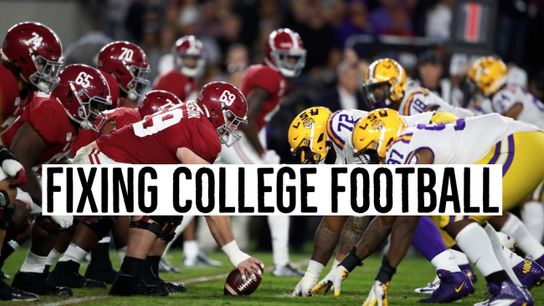We’ve all got nothing but time on our hands these days, and this (forced) downtime gives us all an opportunity to pause and reflect. Coaches across the country take time that would have otherwise been spent analyzing spring practice film to do some self-scouting or deep dives into schematic ideas they wouldn’t otherwise have the time to study. Likewise, I, too, am going back to the drawing board. This is the first in an occasional series where we imagine ways to improve upon God’s favorite sport.
The views expressed here are mine and do not reflect those of my employer’s.
Last time around we argued that the tie was the most misunderstood concept in sports and should be reinstated. Even still if a tie is sometimes a game's true outcome, some games must declare a winner. You simply can't end a championship game or a playoff game in a tie. College football needs an overtime system.
The NCAA announced last year a tweak to its overtime system: after four overtime sessions, teams would skip ahead and alternate 2-point attempts until one team succeeds and the other fails. The change was in response to the 7-overtime LSU-Texas A&M game on the final Saturday of the 2018 regular season, a marathon that saw 197 snaps from scrimmage and lasted one commercial break shy of five hours.
This change, to me, misses the point. By the time the new, shorter overtime sessions arrive, players will have already played an entire game plus four extra frames. This is asking a lot of players bodies, to make an understatement.
There has to be a better way. There is a better way.
The AFC Championship between the New England Patriots and Kansas City Chiefs at the end of the 2018 NFL season inspired nationwide frustration at the NFL's system after the Patriots won the coin toss and ended the game without the Chiefs' offense taking the field. The NFL has long employed a substandard overtime system, and news cycle it generated led to the discussion of the California tiebreaker.
Employed by the California high school system in the 1960s, '70s and '80s, it's a system that is brilliantly simple:
The ball is placed at midfield. Each team gets four snaps, and whoever ends those eight plays with the ball on their side of the field, loses. Here's how I illustrated it at the time:
After winning the coin toss, the Patriots defer and make the Chiefs take the ball first. On first down, Mahomes and company move the ball from midfield to the Patriots�’ 40. After that play is over, Tom Brady and his charges trot to their own 40 and run a play. Wherever the ball happens to be after New England’s first down play — be it a gain of 30 or a loss of 20 — Kansas City’s offense would then come back on the field and run their second down play.
-- It's a gimmick, sure, but it is any less of a gimmick than the current college system where each team gets to skip ahead to their red zone offense? At least in this system, both teams are forced to defend the entire field.
-- TV would love it, because it gives overtime a finite ending that is just an extra eight plays. The networks would surely stuff in a commercial break or three during the change over from one offense to the next, but this guarantees the game would not butt into the broadcast window of the following game.
-- It's a safer option than the current model, because players are playing just four extra snaps.
-- Games would not extend into infinity like they sometimes do in college, but they would not end in a sudden death anticlimax like they can in the NFL, either. Each team gets four plays, and that's it. (If the ball happens to end at midfield after the eight plays, each team could get one extra play until a winner emerged. If one team scored a touchdown before the eighth and final play, the other could then snap the ball from their own goal line.)
More than anything, stop and think of the tactical drama the California tiebreaker would bring to the world. Do you throw deep hoping to land a haymaker, thus risking an incompletion and the ball staying put? If you're a defensive coordinator, do you have the guts to call a blitz and gun for a backbreaking sack?
Close your eyes and imagine Trevor Lawrence trotting on the field with the entire world knowing a 15-yard gain wins the national title for Clemson, and anything short of that wins it for LSU.
Can you imagine how much sweat would start gushing off of Gary Patterson's head if he had to hold Lincoln Riley to less than 10 yards or he'd lose? How many bite marks Nick Saban would take out of Steve Sarkisian's face if he dialed up a failed deep ball on third-and-the-game from Alabama's 45?
You can't. You can't imagine it because the thought alone blows your brain into bits it's so dramatic and entertaining.
The California tiebreaker is the best overtime system. It's better for players. It's better for TV. And it forces coaches to push all their tactical chips to the center of the table, which makes it better for all of us.
